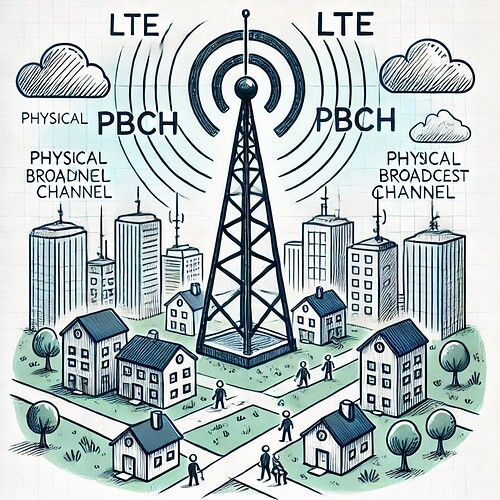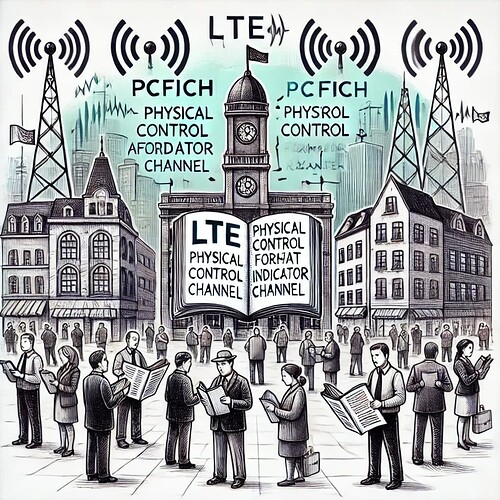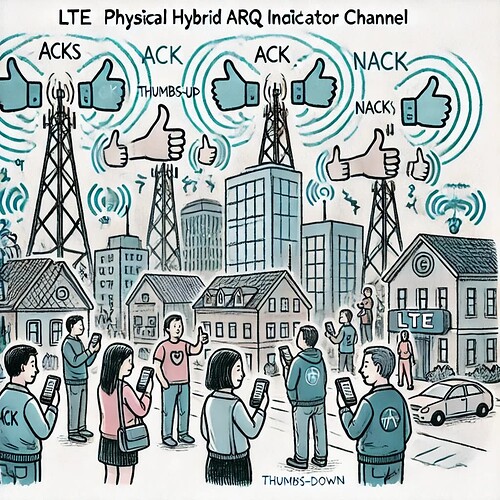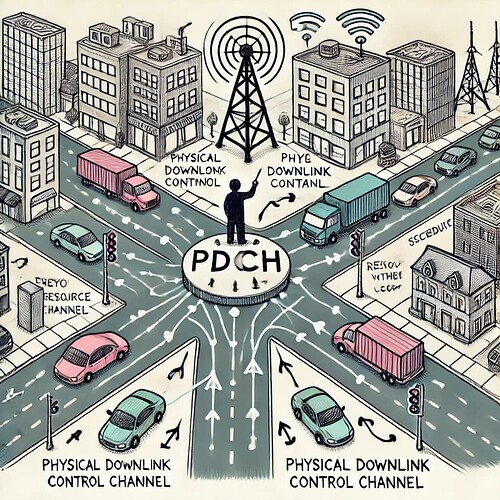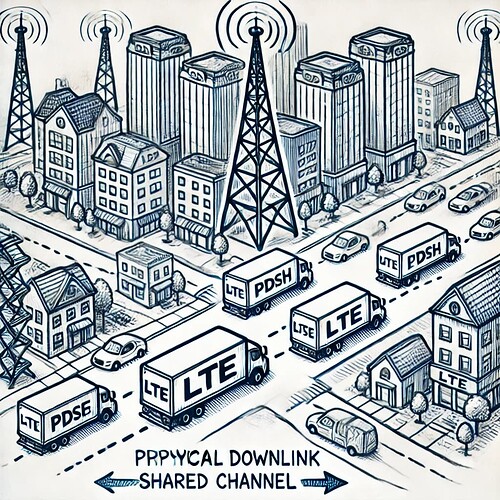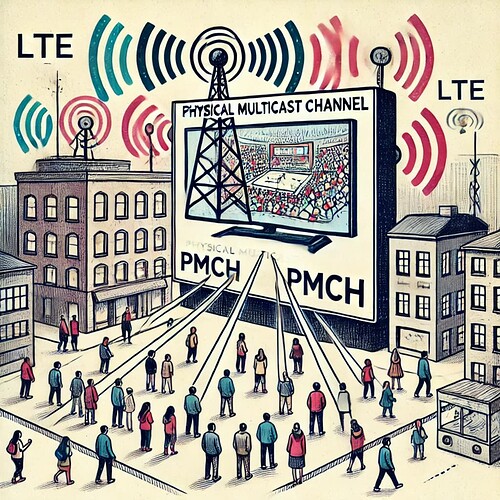This topic presents in a very simplified way all the main concepts that should be understood by those who know LTE.
LTE Downlink Physical Channels
These channels are important because they manage how devices communicate with the network, ensuring everything runs smoothly. Each channel has a specific job: some provide critical information about how the network operates, others help control the flow of data, and some deliver the actual content users request, like videos or messages. Together, they make sure devices know where to send and receive data, when to do it, and how to handle any errors, ensuring a fast and reliable connection for everyone. They work together to manage control signals, system information, and user data, ensuring devices can communicate smoothly with the LTE network.
![]() These channels are important because they help the city (network) stay organized and run smoothly. It’s like having traffic lights, signs, and special roads that tell cars (devices) where to go, when to stop, and how to deliver packages (data) to the right places. Without these channels, everything would be confusing, and cars might crash or get lost. They make sure everyone gets what they need, follows the rules, and travels safely through the city, so everything works perfectly.
These channels are important because they help the city (network) stay organized and run smoothly. It’s like having traffic lights, signs, and special roads that tell cars (devices) where to go, when to stop, and how to deliver packages (data) to the right places. Without these channels, everything would be confusing, and cars might crash or get lost. They make sure everyone gets what they need, follows the rules, and travels safely through the city, so everything works perfectly.
Skip to: Roadmap to LTE
- PBCH (Physical Broadcast Channel)
- PCFICH (Physical Control Format Indicator Channel)
- PHICH (Physical Hybrid ARQ Indicator Channel)
- PDCCH (Physical Downlink Control Channel)
- PDSCH (Physical Downlink Shared Channel)
- PMCH (Physical Multicast Channel)
PBCH (Physical Broadcast Channel)
The PBCH is like a radio station that broadcasts essential information to all devices in the network. It carries the system’s basic configuration, allowing devices to understand how to connect and communicate with the network. It is the channel that carries important system information that all devices need when they first connect to the network. It helps the device understand basic things like the network’s setup and how to communicate.
![]() The PBCH is like the city’s main radio station. It broadcasts important information to everyone, like the city’s rules and how to get around. This helps all the devices (or people) know what to do and where to go. (It tells everyone important information, like where the roads go and the rules of the city. This helps all new visitors (devices) understand how the city (network) works).
The PBCH is like the city’s main radio station. It broadcasts important information to everyone, like the city’s rules and how to get around. This helps all the devices (or people) know what to do and where to go. (It tells everyone important information, like where the roads go and the rules of the city. This helps all new visitors (devices) understand how the city (network) works).
- Search Forum
 LTE Physical Broadcast Channel (PBCH)
LTE Physical Broadcast Channel (PBCH) 
PCFICH (Physical Control Format Indicator Channel)
Think of the PCFICH as a guidebook that tells devices how much space is allocated for control information in each transmission. It ensures that devices know where to find the control signals they need to operate correctly.It tells the device how much space in each transmission is reserved for control information. It helps the device know where to look for the instructions it needs to properly connect and communicate with the network.
![]() Think of the PCFICH as the city’s guidebook. It tells everyone how much space is needed for important announcements. This way, everyone knows where to find the information they need to follow the city’s rules. (It informs devices about where to find control instructions and how much space is reserved for them in each transmission).
Think of the PCFICH as the city’s guidebook. It tells everyone how much space is needed for important announcements. This way, everyone knows where to find the information they need to follow the city’s rules. (It informs devices about where to find control instructions and how much space is reserved for them in each transmission).
PHICH (Physical Hybrid ARQ Indicator Channel)
The PHICH acts like a feedback system. It sends acknowledgments (ACKs) or negative acknowledgments (NACKs) to devices, letting them know if their previous data transmissions were successful or if they need to resend the data. It is used to send feedback to the device about whether the data it sent was received correctly or not. If there were errors, the device can resend the data.
![]() The PHICH is like the city’s feedback system. It sends messages to let people know if their previous actions were successful or if they need to try again. It’s like getting a thumbs up or a thumbs down. (It is like a walkie-talkie that tells you whether your last message was heard clearly or if you need to repeat it. If something goes wrong, this channel lets your device know so it can try again).
The PHICH is like the city’s feedback system. It sends messages to let people know if their previous actions were successful or if they need to try again. It’s like getting a thumbs up or a thumbs down. (It is like a walkie-talkie that tells you whether your last message was heard clearly or if you need to repeat it. If something goes wrong, this channel lets your device know so it can try again).
PDCCH (Physical Downlink Control Channel)
The PDCCH is the traffic controller of the network. It informs devices about resource allocation, scheduling, and other control information, ensuring that data is transmitted efficiently and without interference. It is responsible for carrying control information like scheduling and power levels. It tells the device when and where to expect its data and how much power to use when sending data back to the network.
![]() The PDCCH is the city’s traffic controller. It directs where and when things should happen, making sure everything runs smoothly without any traffic jams. It tells devices when and where they can send and receive information. (It directs where and when cars (data) should go. It tells each car where their lane is and how fast they should go, ensuring everyone knows when it’s their turn to move).
The PDCCH is the city’s traffic controller. It directs where and when things should happen, making sure everything runs smoothly without any traffic jams. It tells devices when and where they can send and receive information. (It directs where and when cars (data) should go. It tells each car where their lane is and how fast they should go, ensuring everyone knows when it’s their turn to move).
- Search Forum
 LTE Physical Downlink Control Channel (PDCCH)
LTE Physical Downlink Control Channel (PDCCH) 
PDSCH (Physical Downlink Shared Channel)
The PDSCH is the main channel for delivering user data, such as internet browsing, video streaming, and other services. It’s the workhorse that carries the actual content users want to access. It is the main channel used to send actual user data, like your internet browsing or video streaming. It delivers the content you requested from the network.
![]() The PDSCH is like the city’s delivery trucks. It carries all the important packages, like internet data, videos, and other content that people want. It’s the main channel for delivering what users need. (It carries the actual data (like a truck carrying goods), delivering things like videos, messages, or web pages to devices).
The PDSCH is like the city’s delivery trucks. It carries all the important packages, like internet data, videos, and other content that people want. It’s the main channel for delivering what users need. (It carries the actual data (like a truck carrying goods), delivering things like videos, messages, or web pages to devices).
- Search Forum
 LTE Physical Downlink Shared Channel (PDSCH)
LTE Physical Downlink Shared Channel (PDSCH) 
PMCH (Physical Multicast Channel)
The PMCH is used for broadcasting the same content to multiple devices simultaneously, like a TV broadcast. It’s efficient for delivering services like live video streaming to many users at once. It is used when the network wants to send the same data to many devices at once, like for broadcasting a live video stream to multiple users. It’s efficient for sending identical information to multiple people.
![]() The PMCH is like the city’s big TV broadcast. It sends the same show to many people at once, like a live sports game or a concert. It’s great for sharing the same content with lots of people at the same time. (It is like a large TV screen in the middle of the city that broadcasts the same message to everyone in the area at once. If the city needs to share important news with many people at once, it uses this channel).
The PMCH is like the city’s big TV broadcast. It sends the same show to many people at once, like a live sports game or a concert. It’s great for sharing the same content with lots of people at the same time. (It is like a large TV screen in the middle of the city that broadcasts the same message to everyone in the area at once. If the city needs to share important news with many people at once, it uses this channel).
- Search Forum
 Physical Multicast Channel (PMCH)
Physical Multicast Channel (PMCH) 
That’s it. ![]()
-
Continue reading: Roadmap to LTE - Downlink Transport Channels
-
Or back to: Roadmap to LTE
